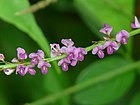Note: This is a project under development. The articles on this wiki are just being initiated and broadly incomplete. You can Help creating new pages.
Difference between revisions of "Desmodium gangeticum - Shaalaparni, Murelehonne"
(→References) |
(→External Links) |
||
| Line 82: | Line 82: | ||
* [http://www.planetayurveda.com/library/shalparni-desmodium-gangeticum Shaalaparni on planetayurveda.com] | * [http://www.planetayurveda.com/library/shalparni-desmodium-gangeticum Shaalaparni on planetayurveda.com] | ||
[[Category:Herbs]] | [[Category:Herbs]] | ||
| + | [[Category:Fabaceae]] | ||
Revision as of 16:58, 23 May 2019
Abrus precatorius is a severely invasive plant in warm temperate to tropical regions, so much so that it has become effectively tropical in distribution. It had been widely introduced by humans, and the brightly coloured and hard-shelled seeds had been spread by birds.
Contents
- 1 Uses
- 2 Parts Used
- 3 Chemical Composition
- 4 Common names
- 5 Properties
- 6 Habit
- 7 Identification
- 8 List of Ayurvedic medicine in which the herb is used
- 9 Where to get the saplings
- 10 Mode of Propagation
- 11 How to plant/cultivate
- 12 Commonly seen growing in areas
- 13 Photo Gallery
- 14 References
- 15 External Links
Uses
Blisters in mouths, Mouth sores, Bleeding piles.
Parts Used
Chemical Composition
It contains Flavonoids, Genistein, Hydroxygenistein, Prenyl, Trimethoxy, Methylenedioxy and Flavone[1]
Common names
| Language | Common name |
|---|---|
| Kannada | Murelehonne, Muruluboane |
| Hindi | Chirpat, Chuppa, Salpalnu |
| Malayalam | Orila, Pullati |
| Tamil | Pulladi, Pullati, Sirupulladi |
| Telugu | Getanaramu, Gitanaram |
| Marathi | NA |
| Gujarathi | NA |
| Punjabi | NA |
| Kashmiri | NA |
| Sanskrit | Shalaparni, Shalidala, Shaliparni |
| English |
Properties
Reference: Dravya - Substance, Rasa - Taste, Guna - Qualities, Veerya - Potency, Vipaka - Post-digesion effect, Karma - Pharmacological activity, Prabhava - Therepeutics.
Dravya
Rasa
Guna
Veerya
Vipaka
Karma
Prabhava
Habit
Identification
Leaf
| Kind | Shape | Feature |
|---|---|---|
| unifoliate | ovate to ovatelanceolate | Membranous, and mottled with grey patches |
Flower
| Type | Size | Color and composition | Stamen | More information |
|---|---|---|---|---|
| Inflorescence | 2-4cm long | purple, lilac to white in colour | Flowering and occur twice a year | Inflorescence is elongated, lax, terminal or axillary raceme |
Fruit
| Type | Size | Mass | Appearance | Seeds | More information |
|---|---|---|---|---|---|
| pod | moniliform (beaded), six to eight jointed | seeds upto 5 | Flowering and fruiting occur twice a year |
Other features
List of Ayurvedic medicine in which the herb is used
Where to get the saplings
Mode of Propagation
How to plant/cultivate
Because of the abundant small uncinate hairs on most species, the seedpods cling most tenaciously to clothing, to any part of the human body, and also to the feathers and hair of various animals, thus ensuring a wide dispersal of the plants.[3]
Commonly seen growing in areas
Tropical area, Caribbean Islands, Subtropical area, Pinelands, Hammocks.
Photo Gallery
References
External Links
- Ayurvedic Herbs known to be helpful to treat Blisters in mouths
- Ayurvedic Herbs known to be helpful to treat Mouth sores
- Ayurvedic Herbs known to be helpful to treat Bleeding piles
- Herbs with Seeds used in medicine
- Herbs with Stem used in medicine
- Herbs with Leaves used in medicine
- Herbs with Roots used in medicine
- Herbs with common name in Kannada
- Herbs with common name in Hindi
- Herbs with common name in Malayalam
- Herbs with common name in Tamil
- Herbs with common name in Telugu
- Herbs with common name in Sanskrit
- Habit - Shrub
- Index of Plants which can be propagated by Seeds
- Herbs that are commonly seen in the region of Tropical area
- Herbs that are commonly seen in the region of Caribbean Islands
- Herbs that are commonly seen in the region of Subtropical area
- Herbs that are commonly seen in the region of Pinelands
- Herbs that are commonly seen in the region of Hammocks
- Herbs
- Fabaceae







